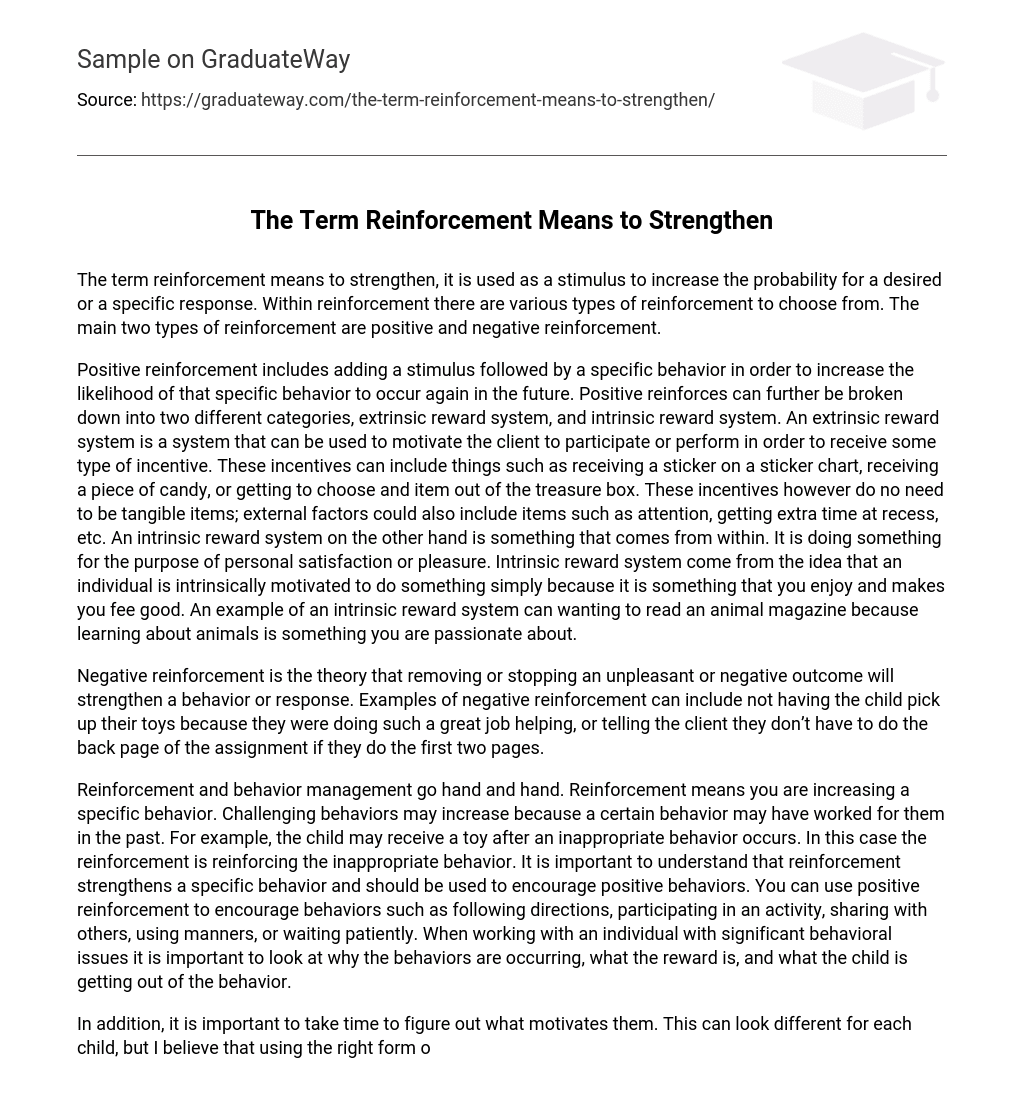The term reinforcement means to strengthen, it is used as a stimulus to increase the probability for a desired or a specific response. Within reinforcement there are various types of reinforcement to choose from. The main two types of reinforcement are positive and negative reinforcement.
Positive reinforcement includes adding a stimulus followed by a specific behavior in order to increase the likelihood of that specific behavior to occur again in the future. Positive reinforces can further be broken down into two different categories, extrinsic reward system, and intrinsic reward system. An extrinsic reward system is a system that can be used to motivate the client to participate or perform in order to receive some type of incentive. These incentives can include things such as receiving a sticker on a sticker chart, receiving a piece of candy, or getting to choose and item out of the treasure box. These incentives however do no need to be tangible items; external factors could also include items such as attention, getting extra time at recess, etc. An intrinsic reward system on the other hand is something that comes from within. It is doing something for the purpose of personal satisfaction or pleasure. Intrinsic reward system come from the idea that an individual is intrinsically motivated to do something simply because it is something that you enjoy and makes you fee good. An example of an intrinsic reward system can wanting to read an animal magazine because learning about animals is something you are passionate about.
Negative reinforcement is the theory that removing or stopping an unpleasant or negative outcome will strengthen a behavior or response. Examples of negative reinforcement can include not having the child pick up their toys because they were doing such a great job helping, or telling the client they don’t have to do the back page of the assignment if they do the first two pages.
Reinforcement and behavior management go hand and hand. Reinforcement means you are increasing a specific behavior. Challenging behaviors may increase because a certain behavior may have worked for them in the past. For example, the child may receive a toy after an inappropriate behavior occurs. In this case the reinforcement is reinforcing the inappropriate behavior. It is important to understand that reinforcement strengthens a specific behavior and should be used to encourage positive behaviors. You can use positive reinforcement to encourage behaviors such as following directions, participating in an activity, sharing with others, using manners, or waiting patiently. When working with an individual with significant behavioral issues it is important to look at why the behaviors are occurring, what the reward is, and what the child is getting out of the behavior.
In addition, it is important to take time to figure out what motivates them. This can look different for each child, but I believe that using the right form of reinforcement can positively change behavior.
I would describe my current proficiency with behavior management as average. For my school caseload, I only have a few students who have significant behaviors and I have not had to deal with the behaviors yet on my own. I have worked/volunteered at many autism camps/clinics so I feel as though I have a basic knowledge of how behavior management should look like. However, observing and implementing behavior management are two vastly different areas. Learning more about behavioral management I feel will come with time and experience.
My personal preferred approach to behavior management as a future speech-language pathologist is to first build rapport with the client before working on therapy. Building rapport is all about trust and allowing the child to feel safe and secure while in the therapy room. A child who has not built rapport with their clinician may show more behavioral issues while in the therapy room. Along with building rapport, I believe it is equally as important to let the child feel as though they have a say in the therapy room and have some sort of control. My supervisor this semester does a phenomenal job of doing this in the therapy room. She starts each session by letting the client choose between two different activities and will let the older children decide on which goal they want to target in the session. Letting the children decide between a few options in the session leads to the child feeling like they have a say or control in the session. I believe building rapport and letting the child have a say in what happens in the therapy room helps in managing behavioral issues.





